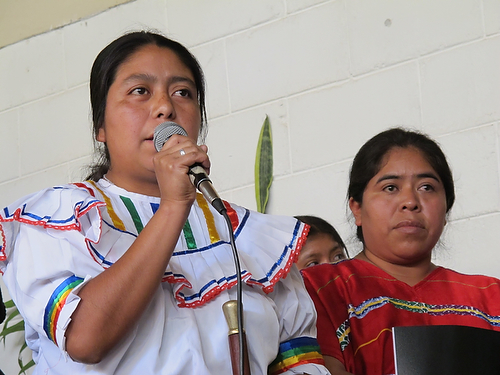
Author's note: Last week, following the visit of U.N. Special Rapporteur on Indigenous Rights James Anaya, the Guatemalan government agreed to abide by his requests and those of the Interamerican Commission on Human Rights, the Catholic Church, the International Labor Organization and others and has ordered the temporary suspension of operations at the Marlin Mine in the indigenous lands of Western Guatemala.
But President Alvaro Colom has said the closure process will take several months, and activists involved with the five-year struggle against Goldcorp, the Canadian owner, are skeptical, saying it's just a delaying tactic to give Goldcorp time to arm a legal response.
Meanwhile, Goldcorp has announced it will continue operations. "We welcome this opportunity to demonstrate once again Goldcorp's record of respectful, environmentally sound operations at Marlin," Goldcorp CEO Chuck Jeannes was quoted in Mineweb, a publication covering the mining industry.
This is the second in a series about Anaya's recent visit to Guatemala and the issues surrounding that visit. More extensive coverage can be found at The Esperanza Project.
SAN MIGUEL IXTAHUACAN -- The road up into this mountain town seems to wind forever upward, and I'm frustrated because we're late. The meeting with the U.N Special Rapporteur on the Rights of Indigenous People, James Anaya, is scheduled to begin his meeting with the people at 8. I don't understand why Joshue is stopping for breakfast.
I needn't have worried. I'm with Josue Navarro and Bart Van Besien, two members of the dedicated staff of COPAE, the Pastoral Commission for Peace and Ecology, and their peaceful trajectory is in keeping with local traditions.
We arrive at the parish hall to find it filled with animated people in their colorful native dress, milling excitedly around a spectacular mandala created from colored sawdust and flowers in the center of the floor -- but no James Anaya. Feeling lucky to find a seat, I settle in and wait; listen to a few speeches and a few marimba tunes, shoot a few photos and wait some more.
This is a big day in San Miguel Ixtahuacan. This small town has drawn big headlines in the past few months, and has been the subject of several documentaries. That's because the transnational Goldcorp has a tremendously profitable mine here, the Marlin Mine, which many in this Mam Maya community say they never agreed to.
Residents complain of strange rashes on their children's skins and other symptoms, of cracks in the walls of houses near the mine, and of repression from local authorities when they dare to speak out against the mine. A recent study by University of Michigan physicians showed elevated levels of heavy metals in the blood of residents living near the mine, but said they were uncertain whether those levels constituted a risk.
Goldcorp officials -- here in Guatemala the subsidiary is called Montana Exploradora - say there is no evidence of contamination, and the government so far has agreed.
The wait stretches into an hour, and suddenly everyone gets up to leave. Everyone seems to know what's going on except Bart and me. "We're going to the field," someone explains to me. The field? "Yes, that's where the helicopter is coming."
Sure enough, everyone was gathering around a big field, holding up signs that expressed their rejection of the mine.
The helicopter landed to great fanfare and paparazzi, and James Anaya emerged from the helicopter: a tall, photogenic man with Native American features and a gentle smile. He and his entourage were greeted by local leaders and led back to the parish for the proceedings.
The first order of business was a ceremony. A group of beautiful young Mam Maya women and men gather around the mandala and perform a graceful dance in honor of the sacred elements, the water, represented by the earthen pots they carry, and the earth, represented by the green tree seedlings they "plant" at the center of the mandala.
Now it was Anaya's turn. Hundreds of traditionally dressed Mam Maya highlanders looked on with bated breath as Anaya, perhaps the world's highest-ranking authority on indigenous issues, knelt before the altar to light the red candle.
"Red signifies abundance, energy and life, and whoever lights the red candle has the responsibility of looking out for the well-being of our community," Sister Maudilia had said, handing the matches to Anaya.
The task was not as easy as it seemed. The wick was short, and the flame wavered and threatened to fail. Anaya, however, was up to the task. He persisted, working with the candle and nurturing the flame until it grew steady.
The onlookers erupted into applause.
Carmen Mejia, a leader of the San Miguel Association for Integral Development, took the mike and began with a short history of the mining company's entrance into the community.
"They entered under deceit and lies; they were offering productive jobs for people here. They didn't say they were a mining company; they never said they were here to extract gold and silver. They said it was a project for development, and they began acquiring lands. Once they had some land they began to coerce the neighbors to sell their land. 'If you don't sell to us, you'll be surrounded and buried,' they were told if they resisted."
The company continued, she said, manipulating and gathering signatures under false pretenses.
"The company is operating illegally, because it lacks the social license to be here," she said. "The people of San Miguel were never consulted."
Exploration of the mine began, and that's when the damage began occurring, she said. Neighbors began speaking out.
"The answer was criminalization, persecution, the threatening of campesinos and campesinas. In 2007, we had seven comrades processed; five were liberated, but two were condemned to three years of prison and liberated, under the condition that they stop speaking out against the mine. In 2008, eight women campesina leaders, indigenous Mam Maya women, were under an order of capture, just for speaking out for their rights. In 2009, five campesinos were arrested and charged, and in 2010 five more. And why? Because the people of San Miguel have demanded their rights.
"They've spoken out for their right to life, for their right to water; for their right to safe homes. In San Miguel, more than 120 houses have been cracked and broken, their lives are in danger ... They've spoken out for the environment, for the rivers and the flora and the fauna that are being contaminated.
"This is what we're living here in San Miguel; we're seeing more illnesses, in the people and in the animals, including animals that have died after drinking contaminated water.
"Seeing all of this, seeing all of the manipulation and the criminalization and the conflict that has occurred at the community level, we have come to the conclusion that an extractive industry like a mine is not compatible with a Mam community."
Anaya heard from a labor leader who said there were miners who had been injured and who knew about the contamination but weren't free to talk, a women's rights leader who said the company claims to be giving women opportunities but that they are being manipulated and exploited, and from a number of others.
"Next you'll go and speak to the government officials and the mining officials, and they'll tell you we're just a little grupito of troublemakers," said a man introduced as Don Ricardo. "But we are not a grupito. We are thousands. We represent our communities, and we represent many more who are afraid to speak up because of the reprisals."
Sister Maudilia López, of FREDEMI (Front in Resistance of San Miguel), a Catholic sister and a Mam Maya leader of the resistance against the mining, presented the officials with handmade earthen pots used for carrying water.
"These are humble works, but they are made by our own hands, and we make them not to do damage but to give life -- to share the sacred good that is water," Maudilia said earnestly. "I ask myself, why are we doing damage to our Mother Earth, and to all of the mothers who make these pots from our Mother Earth? This is not a development for life, it's a development for death."
Tracy L. Barnett is an independent writer currently traveling through Latin America. For more extensive coverage of the indigenous struggle to protect their lands and other sustainability initiatives throughout the Americas, visit The Esperanza Project. She can be reached at tracy@tracybarnettonline.com; comments, suggestions and collaborations are welcome.

